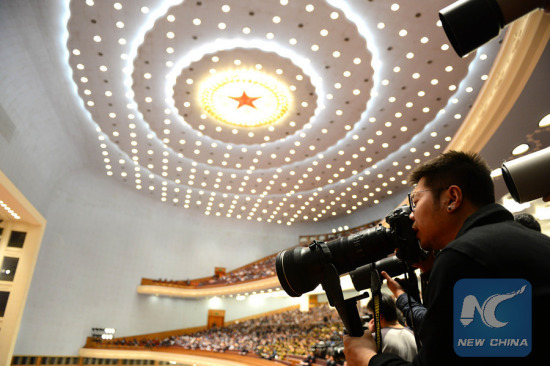
Photographers work at the Great Hall of the People during the opening meeting of the fourth session of China's 12th National People's Congress in Beijing, capital of China, March 5, 2016. (Photo: Xinhua/Liu Junxi)
International observers and media on Saturday followed two nationally important meetings going on in China, for clues on how resilient the huge economy is in a tough but necessary transition and how other economies may ride on its further growth.[Special coverage]
Japan's video-sharing portal niconico streamed a live broadcast of the opening of the annual plenary session of the National People's Congress of China and an address by Premier Li Keqiang to present a report on the work of his government, producing over 10,000 comments by viewers.
An annual plenary session of the Chinese People's Political Consultative Conference (CPPCC) is also going on in Beijing. The two meetings, known as "Two Sessions," are closely watched by observers who want to get more information on China's development plans and policies.
Banri Kaieda, former chief of the Democratic Party of Japan, noted in a discussion that China aims to turn itself into a relatively well-off nation by 2020 by implementing its 13th five-year development plan.
Premier Li reviewed the progress made over the past year and outlined the plan for the next five years, particularly the efforts to be made this year to ensure steady economic growth while pushing forward reforms.
He said that China expects a growth of 6.5 percent to 7 percent this year, proposing an increase in budget deficit to 3 percent of the gross domestic product (GDP) to ensure economic growth remains on track.
Some international media outlets carried headlines saying that China has cut its growth target to between 6.5 percent and 7 percent, while acknowledging that it is still among the fastest in the world.
China has enjoyed growth averaging some 10 percent annually over the three decades since opening up in the late 1970s.
Bambang Suryono, president of the Nanyang ASEAN Foundation in Indonesia, said it is natural for China to slow down as the economic growth is now achieved on a much larger base. China's growth at the current speed means more added output than what its 10-percent growth meant several years ago.
China is now pushing through a transition from growth driven largely by export and investment to growth driven more by domestic consumption. The government has been encouraging innovation and entrepreneurship in order to achieve more sustainable growth.
Its services sector has been growing fast, now accounting for slightly more than 50 percent of the GDP, which means there is still potential if compared with around 80 percent for developed economies.
"The government work report mentioned the pursuit of high-quality growth and stressed the importance of increasing domestic demand. These efforts, if successful, should help China achieve its goal of transforming the economy and bettering the life of the people," said Dr. Oh Ei Sun, former political advisor to Malaysian Prime Minister Najib Razak.
International media quoted Li as saying that the Chinese economy remains resilient while acknowledging tough challenges ahead. He has said that inflation has remained low while job creation has come out better than expected with about 13.12 million new jobs made available last year, despite the slightly slower economic growth of 6.9 percent.
"The Chinese government still has ample macroeconomic policy space to manage a slowdown in its economy. So it should not be a big worry for the international community," Suryono said.
The proposed fiscal deficit equivalent to 3 percent of the GDP, though higher than the previous year's target of 2.3 percent, is still not as high as some economists think it can be.
China has tried to avoid overly expansionary fiscal policies in order to push ahead the needed economic restructuring.
The Chinese premier also mentioned plans to significantly reduce overcapacity in industries such as steel and coal, even though this will mean many workers to be laid off over the next two to three years. The government has set aside billions of yuan to support them through difficulties and help them with skill upgrading through training.
In addition, the Chinese premier outlined plans to cut emission, carry on with financial sector reforms, further open up the economy to competition, continue to streamline government procedures, and create at least 50 million jobs in cities by 2020.
The report shows China is paying much attention to its environment issues, Kaieda said in a discussion on the meetings in China.
"Japan has advanced environment technologies. Japan and China can cooperate on environment protection," he said.


















































